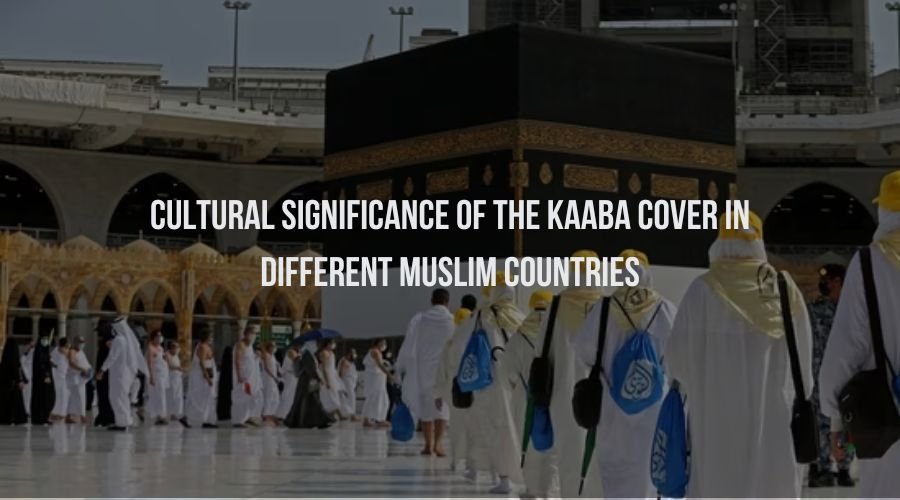The Kaaba, a cubical structure in Mecca, Saudi Arabia, is the holiest site in Islam. It serves as the focal point for prayer ( salat) for Muslims worldwide, and millions embark on the Hajj pilgrimage each year to circumambulate (tawaf) this sacred site. Draped in a magnificent cloth adorned with intricate calligraphy, the Kaaba Cover, also known as the Kiswa, holds immense cultural significance that transcends its physical form. Let’s delve into the rich tapestry of meaning woven into the Kiswa and explore its impact on Muslim communities across the globe.
A Symbol of Unity and Equality
The Kiswa is a large, black cloth adorned with Quranic calligraphy in gold and silver thread. It’s more than just a decorative element; it signifies respect and reverence for the Kaaba. The annual replacement ceremony in Mecca is a momentous occasion, watched by Muslims around the world. This act of renewal emphasizes the importance of maintaining the Kaaba’s purity and grandeur.
The Kiswa transcends geographical and cultural boundaries. It represents the unity of the Muslim Ummah (community). Regardless of ethnicity, language, or local customs, Muslims worldwide acknowledge the Kaaba’s centrality to their faith. The Kiswa serves as a visual reminder of this unifying bond.
The Kiswa Inspiration in Islamic Decor
The powerful symbolism of the Kiswa finds expression in various aspects of Muslim life, particularly in Islamic decor. Here are some fascinating examples:
Mosques
Mosques, the centers of Muslim worship, often incorporate elements that evoke the Kaaba. This can be through the use of black and gold color schemes, intricate geometric patterns reminiscent of the Kiswa’s embroidery, or even miniature replicas of the Kaaba displayed within the mosque.
Homes
The desire to connect with the sacred space of the Kaaba extends to Muslim homes. Many Muslim home decor items incorporate elements inspired by the Kaaba Kiswa. This might involve Islamic wall art featuring the Kaaba itself, or calligraphy replicating verses from the Quran found on the Kiswa. Black and gold accents in furniture, or tableware can also subtly reference the Kaaba cover.
Islamic Art
The rich tradition of Islamic art draws inspiration from the Kiswa’s aesthetic qualities. Calligraphers may incorporate the specific fonts used on the Kiswa into their work. Textile artists might weave intricate geometric patterns reminiscent of the Kiswa’s embroidery. These artistic expressions pay homage to the Kaaba while showcasing the remarkable craftsmanship within Muslim communities.
The Kiswa's Influence Around the World
While the core significance of the Kiswa remains consistent, its influence on Islamic decor manifests differently across the Muslim world:
Indonesia
Here, Islamic calligraphy flourishes in a unique style known as kaligrafi Islam Indonesia. Indonesian artists might incorporate verses from the Kiswa into their work, using vibrant colors and local design elements alongside the traditional black and gold.
Turkey
Turkish Islamic decor is known for its exquisite tilework and intricate geometric patterns. These elements might be used to create stunning borders or frames around images of the Kaaba or calligraphy inspired by the Kiswa.
Pakistan
Pakistani Muslims revere the Kiswa for its connection to the Prophet Abraham, considered the patriarch of Islam. The black color of the Kiswa is seen as a symbol of humility and equality before God.
West Africa
West African Islamic decor is known for its vibrant colors and bold geometric patterns. These influences might be incorporated into wall hangings or textiles depicting the Kaaba, adding a touch of local flair to the homage.
India
In India, the Mughal empire incorporated elements reminiscent of the Kiswa into their iconic architecture. The black and white marble of the Taj Mahal evokes the colors of the Kiswa, while intricate floral designs on mosque walls echo the embroidery patterns.
The Spiritual Connection with Kiswa
The influence of the Kiswa goes beyond mere aesthetics. For Muslims, incorporating elements inspired by the Kaaba cover in their homes or workplaces serves as a constant reminder of their faith. It’s a way to connect with the holiest site in Islam and feel a sense of spiritual closeness to the Kaaba, even if they haven’t undertaken the Hajj pilgrimage.
Conclusion
While the Kiswa itself isn’t available for purchase, its influence can be seen in a multitude of beautiful Islamic art and Muslim home decor items. If you’re looking to explore muslim home decor that reflects the symbolism and beauty of the Kiswa, a reputable store like Kiswah Islamic Store offers a variety of Islamic wall art and other muslim home decor pieces inspired by the Kaaba cover’s design motifs.
The next time you see these artistic expressions, remember the story they tell – a story of faith, unity, and the enduring connection Muslims feel towards the heart of their religion.




